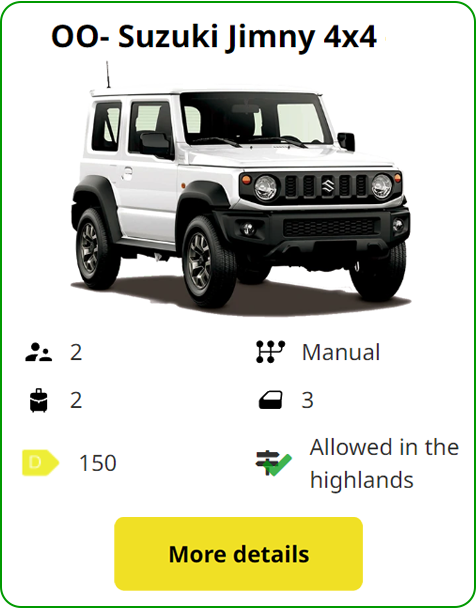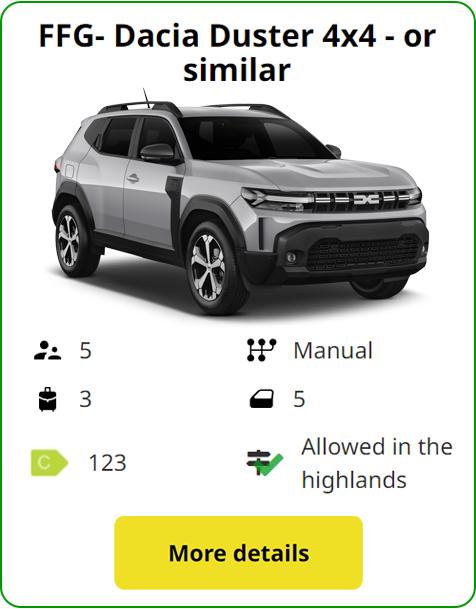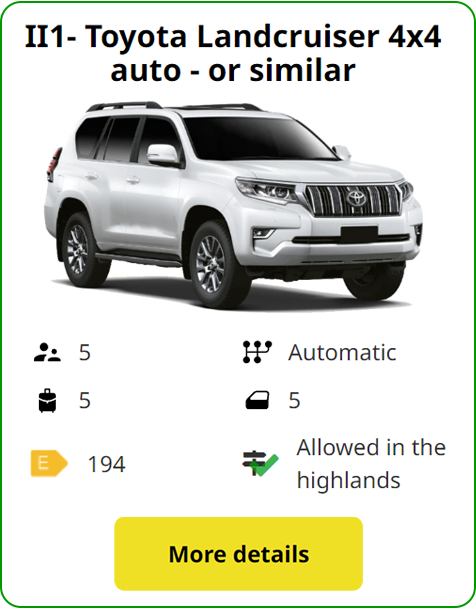- Vehicle Guide
- Passenger cars
- Estate
- Electric
- 4x4 SUVs
- Suzuki Jimny 4x4
- Dacia Duster 4x4
- Suzuki Vitara 4x4
- Suzuki Vitara auto 4x4
- Dacia Bigster 4x4
- Kia Sportage 4x4 Auto
- Kia Sportage PHEV 4x4 auto
- Mitsubishi Outlander PHEV 4x4 auto
- Toyota Rav4 4x4
- Toyota Rav4 4x4 auto
- Kia Sorento 4x4 auto
- Toyota Landcruiser 150 4x4 auto
- Toyota Landcruiser 250 4x4 auto
- Landrover Discovery 5 4x4 auto
- Landrover Defender 4x4 auto
- Prestige
- Minivans
- 4x4 Camper
- Motorhomes
- Driving in Iceland
- Our services
- Locations & Hours
- Travel Inspiration
- South Iceland: A complete guide
- Reynisfjara Beach in Iceland - Your Guide to a Safe Visit
- Best Times to Visit the Golden Circle in Iceland
- North Iceland: A Complete Guide for Drivers
- East Iceland A Complete Guide for Drivers
- West Iceland The Complete Driver’s Guide
- Your Ultimate Guide to Exploring Iceland’s Ring Road
- Driving the Diamond Circle in Iceland: Your Ultimate Guide
- Driving Iceland's Golden Circle: Your Ultimate Guide
- A 10-Day Itinerary in Iceland: Tips + Ideas
- The Perfect Itinerary for 7 Days in Iceland
- The Best Time to See the Northern Lights in Iceland with a Rental Car
- Renting a Camper in Iceland: The Complete Guide
- Getting to Iceland: A Comprehensive Guide on How to Reach the Land of Fire and Ice
- Nature Bath Locations in Iceland: A Complete Guide
- Iceland with Kids: A 5-Day Self-Drive Itinerary
- Winter Driving in Iceland: A Comprehensive Overview for Foreign Tourists
- The Total Solar Eclipse in Iceland – August 12, 2026
- Exploring Iceland's National Parks on a Self-Drive Adventure
- Exploring Iceland's Wonders: A Comprehensive Guide to Activities and Car Rentals
- Springtime in Iceland – Your Comprehensive Travel Guide
- Exploring Iceland's Most Popular Highland Routes
- The Pearls of Westfjords: The Ultimate Guide
- Exploring Iceland's Hidden Gems | Off-the-Beaten-Path Adventures
- Driving in Iceland in June: Tips for a Safe and Scenic Summer Road Trip
- Driving in Iceland in July: Tips, Routes & Rentals
- Driving in Iceland in August: Late-Summer Freedom on the Open Road
- Guide to Skaftafell Iceland Self-Drive A Journey Through Fire and Ice
- Eco-Friendly Road Trips in Iceland, Sustainable Travel Tips
- Photographer’s Paradise Top Scenic Drives in Iceland for Stunning Shots
- Iceland's Folklore and Legends A Road Trip Through Mythical Sites
- Iceland’s Midnight Sun and How to Make the Most of 24-Hour Daylight
- Exploring Iceland’s Viking Heritage: Top Historical Sites
- Chasing Waterfalls: A Road Trip to Iceland’s Most Spectacular Cascades
- Iceland's Volcanic Wonders: A Self-Drive Tour of Active and Dormant Volcanoes
- Tee Off in the Land of Fire and Ice: A Guide to Golfing in Iceland
- Birdwatching in Iceland: Puffins and Beyond
- Iceland’s Diverse Beaches: Beyond the Black Sands
- Icelandic Horses: The Unique Breed of the North
- Beyond the Ring Road: Iceland’s Hidden Scenic Drives
- Iceland’s Ice Caves: A Year-Round Adventure
- Wildlife Watching in Iceland: Where and When to Go
- Iceland’s Hidden Hot Springs: A Self-Drive Guide to Secret Soaks
- Navigating Iceland’s Weather: What to Expect Each Season
- Tröllaskagi Peninsula: Iceland’s Mountainous Marvel — A Scenic Road Trip with Höldur
- Mastering Iceland's Roundabouts: A Driver’s Guide
- Essential Tips for Renting a Car in Iceland
- Navigating Iceland’s One-Lane Bridges: Your Guide to Safe and Scenic Crossings
- Exploring Iceland’s Film Locations by Rental Car
- 5 Must-Visit Destinations Within Two Hours of Keflavík Airport
- Seasonal Car Rental Tips for Iceland’s Summer Festivals
- Understanding Iceland's F-Roads: How to Drive Safely Into the Highlands
- What Makes Iceland Unique: Top 15 Highlights for an Unforgettable Journey
- Driving and Hiking in Harmony: Explore Iceland's Natural Wonders with Höldur Car Rental
- Best Car to Rent in Iceland?
- Avoiding Common Car Rental Mistakes in Iceland
- Making Your Car Rental in Iceland Child-Friendly: Tips for Stress-Free Family Travel
- Exploring Akureyri, Iceland’s Northern Gem, with EasyJet and Europcar
- Renting a Manual or Automatic Car in Iceland
- Discover the Arctic Coast Way in Iceland with Höldur Car Rental
- How to Save on Fuel Costs During Your Iceland Road Trip
- Electric vs. 4x4 Rentals in Iceland: Which is Right for Your Trip?
- Top Scenic Detours Off Iceland's Ring Road
- Top Safety Tips for First-Time Drivers on Iceland’s Roads
- Cultural Pit Stops Along Iceland’s Ring Road
- Your Guide to Exploring Stuðlagil Canyon by Car: Iceland’s Basalt Beauty Awaits
- Day Trip Ideas From Reykjavik by Rental Car
- Visit Glymur Waterfall: The Ultimate Self-Drive Adventure from Reykjavík
- Discover the Volcanic Wonders of Lake Mývatn by Car
- Discovering the Magic of Snæfellsnes Peninsula by Car
- Your Self‑Drive Guide to Gullfoss Waterfall
- A Guide to Seljalandsfoss Waterfall in Iceland: Explore by Car
- Exploring Reykjanes Peninsula A Self Drive Guide
- Exploring Iceland Landmannalaugar by 4x4
- A Beginner's Guide to River Crossings in Iceland
- Best Car Rental Offers for Iceland’s Summer Adventures
- Your Self‑Drive Guide to Þingvellir National Park
- Your Ultimate Guide to Geysir, Iceland: All You Need to Know
- How to Pay for the Vaðlaheiðargöng Tunnel
- Your Guide to Visiting Jökulsárlón Glacier Lagoon
- The Diamond Beach in Iceland: A Sparkling Wonder Worth Visiting
- Parking fines in Iceland: how to pay and what to do if you receive one
- Where to find overnight parking in Reykjavík: a local’s guide for travellers
- How to park for free in Reykjavík: tips to save on your Iceland trip
- How to pay for parking in Reykjavík - A friendly guide for drivers in Iceland
- Game of Thrones Filming Locations in Iceland: A Self-Drive Guide
- How to Choose the Right Car Rental at Keflavík Airport
- Flying Within Iceland: Your Guide to Domestic Routes and Regional Airports
- Top 3 Must-See Attractions on Iceland's Golden Circle
- Hidden Gems Along the Golden Circle Route
- Your Essential Guide to Iceland: Currency, Culture, and Car Rental Tips
- How to Plan the Perfect Golden Circle Self-Drive Tour
- The Comprehensive Guide to Rental Car Sizes at Keflavik Airport
- Húsafell & Hallmundarhraun: Hidden Lava Field Adventures by Car
- Iceland Weather by Month: What to Expect and How to Drive Safely with Holdur Car Rental
- A Guide to Iceland’s Quirky Roadside Attractions
- Exploring Iceland’s Lava Tubes | Self-Drive Cave Adventures with Höldur Car Rental
- Coolcation in Iceland: Self-Drive Your Summer Escape to the North
- Driving Iceland’s Coastal Roads: A Guide to Lesser-Known Peninsulas
- Top Tips for Driving in Iceland Safely Year-Round
- The Best Rest Stops and Viewpoints Along Iceland's Ring Road
- Driving in Iceland in September: Embrace the Autumn Adventure
- Your Guide to Exploring Fjaðrárgljúfur – South Iceland’s Fairytale Canyon
- Explore Reykholt on a Self-Drive Tour in Iceland
- How to Choose the Right Insurance for Your Iceland Car Rental
- Hiking Múlagljúfur Canyon: Iceland’s Hidden Gem You Can’t Miss
- Understanding Iceland's Weather and How It Affects Driving Conditions
- Dyrhólaey: A Complete Self-Drive Guide to Iceland's Breathtaking South Coast
- Where to See Iceland’s Tectonic Plates Up Close
- Scenic Journey on Kjalvegur Road 35 Reykjavik to Akureyri
- Guide to Visiting Svartifoss with a Rental Car
- Kerið Crater Lake in Iceland: A Self-Drive Guide
- Your Complete Guide to Stokksnes, Iceland with a Rental Car
- Hengifoss Waterfall in Iceland: The Ultimate Self-Drive Guide
- Your Complete Guide to Visiting Skógafoss Waterfall with a Rental Car
- Into the Heart of Þórsmörk: Iceland’s Valley of Thunder
- Dynjandi Waterfall in Iceland: The Ultimate Self-Drive Guide
- Visiting Ásbyrgi Canyon in North Iceland by Car: A Complete Self-Drive Guide
- Driving in Iceland in October: Embrace the Autumn Transition
- Hraunfossar: Iceland’s Hidden Gem for Self-Drive Travellers
- Barnafoss Waterfall: Iceland’s Raging Cascade with a Legend
- Driving in Iceland in November: Your Complete Guide to a Spectacular Autumn Adventure
- Fishing in Iceland: All You Need to Know
- Öxarárfoss Waterfall in Iceland: A Self-Drive Guide with Höldur
- Life in Iceland: Essential Guide to Living in the Land of Fire and Ice
- People of Iceland - 12 Fun Facts About Icelanders
- Glaumbær Turf Houses: A Self-Drive Guide to Iceland’s Living History
- Húsavík: Whale Watching Capital of Iceland
- Svínafellsjökull Glacier: A Self-Drive Guide to Iceland’s Ice Giants
- Kirkjubæjarklaustur: A Historic South Coast Gem
- Vík í Mýrdal: South Iceland’s Coastal Treasure
- Namaskard: A Self-Drive Guide to Iceland’s Geothermal Wonderland
- Laufás Heritage Site: Where Iceland’s Past Lives On
- Navigating Iceland's Gravel Roads: Tips for a Safe and Smooth Drive
- Iceland's Best Stargazing Spots for Self-Drive Travellers
- Iceland's Best Picnic Spots: Scenic Stops for Self-Drive Adventures
- Top 5 Family-Friendly Hiking Trails Accessible by Rental Car
- 15 Tips for Travelling to Iceland
- How to Plan a Winter Photography Road Trip in Iceland
- Visiting Gljúfrabúi Waterfall — A Self-Drive Guide
- How to Spot Puffins in Iceland: A Self-Drive Adventure
- Your Essential Guide to Winter Tyres and Safe Driving in Iceland
- Iceland’s Most Active Volcanoes: A Self-Drive Guide
- Iceland’s Most Scenic Bridges and River Crossings: A Self-Drive Guide
- Iceland’s Most Instagrammable Spots for Self-Drive Travellers
- How Cold Is It in Iceland During Winter? A Self-Drive Guide
- Explore Dimmuborgir: A Self-Drive Guide to Iceland's Dark Castles
- The Ultimate Guide to Iceland’s Top 5 Waterfalls by Car
- Iceland’s Best Scenic Routes for Autumn Foliage: A Self-Drive Guide
- The Best Time to Visit Iceland for Self-Drive Travellers
- Self-Drive Adventures to Iceland’s Remote Lighthouses
- Selfoss Waterfall Self-Drive Guide: Explore Iceland Your Way
- All About the Icelandic Sheep
- Vestrahorn: A Self-Drive Guide to Iceland’s Stokksnes Peninsula
- Höfn, Iceland: The Lobster Town Self-Drive Guide
- Exploring Arnarstapi: A Self-Drive Guide
- A Guide to Iceland's Seasonal Foods for Your Road Trip
- Hverfjall Crater, Iceland: A Self-Drive Guide
- Self-Drive Guide to Visiting Askja
- A Self-Drive Guide to Visiting Kerlingarfjöll
- A Self-Drive Guide to Gunnuhver Geothermal Area
- Skriduklaustur, Iceland: A Self-Drive Guide to History & Culture
- Your Ultimate Guide to Visiting the Blue Lagoon in Iceland
- Borgarnes, Iceland: Top Things to Do & Self-Drive Guide
- A Guide to Glaciers in Iceland
- Car Rental Insurance in Iceland: What’s Usually Included, What’s Not & How to Choose
- Best Car Models for Iceland’s Terrain: Recommendations by Route
- Solo Traveller’s Guide to Self-Driving in Iceland
- Exploring Iceland’s Arctic Circle: What to See and Do
- How to Plan a Budget-Friendly Road Trip in Iceland
- The History of Iceland’s National Day: A Self-Drive Celebration
- Where to Spot Whales in Iceland: A Self-Drive Guide
- The Diamond Circle vs. The Golden Circle: Which Route is Right for You?
- Embracing a Greener Journey: Sustainability in Iceland
- Granni: A Self-Drive Guide to Iceland’s Neighboring Waterfall
- Háifoss: A Self-Drive Guide to Iceland’s Tallest Waterfall
- Iceland's Best Camping Spots for Road Trippers
- Gjáin: A Self-Drive Guide to Iceland’s Hidden Oasis
- Iceland's Hidden Waterfalls: Beyond the Tourist Trails
- Hjálparfoss: A Self-Drive Guide to Iceland’s Helping Falls
- Seasonal Self-Drive Itineraries in Iceland: What’s Open When?
- Kirkjufell: A Self-Drive Guide to Iceland’s Most Photographed Mountain
- Fjallabak Nature Reserve: A Self-Drive Guide to Iceland’s Rugged Highlands
- Hrafntinnusker: A Self-Drive and Hiking Guide to Iceland’s Obsidian Wilderness
- When to Visit Iceland: Northern Lights and Ice Caves vs. Hiking and Highland Adventures
- Visiting Laugarvatn Fontana Spa with a Rental Car: A Relaxing Icelandic Getaway
- Hvítserkur Rock: A Self-Drive Guide to Iceland’s Dragon of the North
- Skiing in Iceland: A Self-Drive Guide for Winter Adventurers
- Visiting the Mývatn Nature Baths by Car: A Self-Drive Guide
- Visiting Vök Baths in East Iceland: A Self-Drive Guide
- Visiting Skútustaðir Pseudo-Craters: A Self-Drive Guide
- Visiting Hljóðaklettar: A Self-Drive Guide on the Diamond Circle
- The Ultimate Guide to Exploring Reykjavik with a Rental Car
- Visiting Seljavallalaug: A Hidden Gem in South Iceland
- Guide to Sólheimajökull Glacier by Iceland Car Rental
- Eyjafjallajökull: Iceland’s Glacier Volcano
- Ísafjörður, Iceland: Your Ultimate Self-Drive Guide to the Westfjords
- What Continent is Iceland In? A Traveler's Guide
- Katla Volcano: A Guide to Iceland's Sleeping Giant
- The Magic of Icelandic Water: A Traveler's Guide
- A Guide to Exploring Akureyri by Rental Car
- A Self-Drive Guide to the Krafla Volcanic Region
- 12-Day Iceland Self-Drive: The Complete Itinerary
- Hekla Volcano: A Self-Drive Guide to Iceland's Gateway
- Visiting Deildartunguhver: A Self-Drive Guide to Europe’s Most Powerful Hot Spring
- Exploring Borgarfjörður: A Self-Drive Guide to West Iceland
- Exploring Stórurð: A Self-Drive and Hiking Guide to East Iceland
- Visiting the Forest Lagoon in North Iceland: A Self-Drive Guide
- Driving in Iceland in December: Embrace the Winter Wonderland
- Exploring Grábrók: A Self-Drive Guide to Iceland’s Volcanic Crater
- Exploring Látrabjarg: A Self-Drive Guide to Iceland’s Westernmost Point
- Iceland Car Hire Tips for UK Drivers: What You Need to Know
- 4-Day Iceland Winter Itinerary: The Best of the South
- Mount Mælifell: Iceland’s Emerald Volcano
- How Long to Drive Around Iceland? A Self-Drive Guide
- Driving in Iceland in January
- Exploring Djúpavík: A Self-Drive Guide to Iceland’s Remote Westfjords
- What to Wear in Iceland: Tips for Every Season
- Things to Do in Stykkishólmur: A Self-Drive Adventure Through Iceland’s Magical West
- The Secret Lagoon: Iceland’s Hidden Gem of Relaxation and Discovery
- The Silver Circle of Borgarfjörður: Your Ultimate Self-Drive Guide
- Snæfellsjökull: A Journey to Iceland’s Glacier of Legends
- Car Rental Iceland 4x4: Best 4WD Options for Your Trip
- What to See in Iceland: 20 Places You Don’t Want to Miss
- How to Prepare for an Iceland Road Trip
- Your Guide to Visiting Fagrifoss Waterfall by Car
- Exploring Stakkholtsgjá Canyon: A Self-Drive Adventure in Iceland
- Kolugljúfur Canyon: A Guide to Iceland's Hidden Gem
- Exploring Kvernufoss: A Hidden Gem in South Iceland
- Skógar Museum: A Journey Through Iceland's History
- 2 Days in Iceland: The Perfect Itinerary
- Exploring Berserkjahraun: A Self-Drive Guide to Iceland’s Lava Fields
- Driving in Iceland in February: Your Complete Guide
- Iceland Daylight Hours by Month: Planning Your Trip
- Petra’s Stone Collection: A Self-Drive Gem in East Iceland
- Iceland's New Kilometer-Based Road Tax: Everything You Need to Know
Winter Car Rental in Iceland
Your Guide to Safe and Memorable Adventures
An Icelandic winter road trip is an experience like no other. The landscape transforms into a magical world of snow-dusted mountains, frozen waterfalls, and ethereal ice caves, all under the potential glow of the Northern Lights. While the beauty is undeniable, a successful winter journey depends on thorough preparation and, most importantly, the right vehicle. A winter car rental in Iceland is your key to unlocking this spectacular season safely and comfortably.
Navigating Iceland during winter requires an understanding of its unique conditions. This guide provides a comprehensive overview of everything you need to know, from choosing the correct vehicle and understanding road safety to preparing for the island's famously unpredictable weather. With the right information and a reliable car, your winter adventure will be both safe and unforgettable.

Why a Winter-Ready Car Rental is Essential
Driving in Iceland in winter presents challenges that are likely different from what you experience at home.
Conditions can change in an instant, with snow, ice, and strong winds being common occurrences. Your safety and enjoyment depend heavily on your vehicle's capabilities.
At Höldur, we ensure every vehicle in our fleet is prepared for the season. From November 1st to April 15th, our cars are equipped with high-quality studded winter tyres as mandated by Icelandic law. This is not just a recommendation; it is a critical safety feature that provides the necessary grip to handle icy and snowy roads, significantly reducing braking distances and helping prevent slides.
Extra Peace of Mind: Comprehensive Insurance Coverage
With winter road conditions, extra protection matters. That's why we offer a range of insurance options designed to give you greater confidence and less worry on your journey. Our coverage can include:
- Collision Damage Waiver (CDW): Reduces your financial liability in case of accidents.
- Gravel Protection (GP): Shields you from common gravel-related damage.
- Sand and Ash Damage Waiver (SADW): Offers protection during Iceland's occasional volcanic sand and ash storms.
- Theft Protection (TP): Reduces your responsibility in the rare event of theft.
- Super CDW (SCDW): Further lowers your deductible for added security.
Choosing these coverages—some included and others easily added to your booking—means you can focus more on Iceland’s beauty and less on unexpected costs. Please review the latest options and what's included with your rental during the booking process.
Choosing the Right Vehicle: 2WD vs. 4x4
While a 2WD vehicle may be sufficient for driving within Reykjavík, a 4x4 SUV is highly recommended for any travel outside the capital area. A 4x4 offers several distinct advantages for a winter road trip:
- Improved Traction: Four-wheel drive provides superior grip on snowy and icy surfaces.
- Higher Clearance: A 4x4 sits higher off the ground, making it better suited for driving through deeper snow.
- Enhanced Stability: The added weight and power distribution make the vehicle more stable in high winds, which are a common feature of the Icelandic climate.
Opting for a 4x4 rental provides an essential layer of security, giving you the confidence to explore Iceland’s stunning winter landscapes.
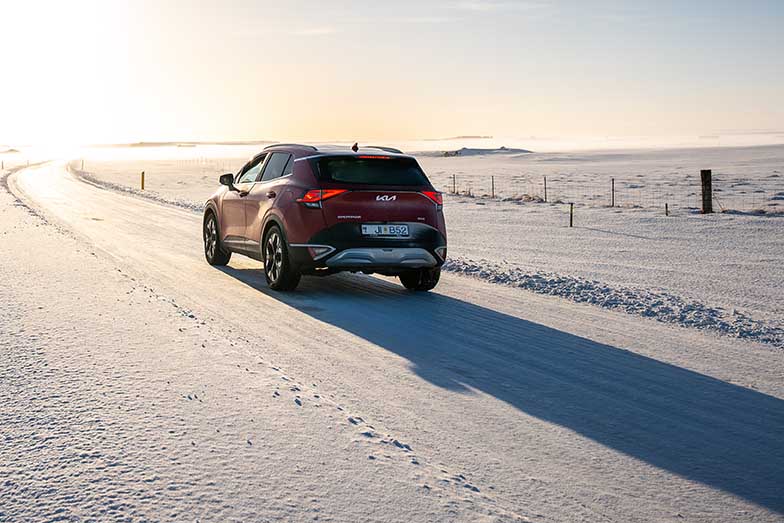
Understanding Winter Driving Conditions in Iceland
Success on an Iceland winter road trip comes down to respecting the conditions and staying informed.
The weather dictates everything, from your daily itinerary to your driving style. One of winter’s greatest rewards is the chance to see the Northern Lights. With your own rental car, you gain the freedom to seek out clear skies in real time, increasing your chances of witnessing this natural phenomenon away from city lights and crowds.
Iceland’s Winter Weather and Temperatures
Contrary to its name, Iceland's winter temperatures are often milder than many parts of North America and mainland Europe, thanks to the warming influence of the Gulf Stream. In Reykjavík and along the South Coast, average temperatures typically range from -1°C to +3°C (30°F to 37°F). However, the wind chill factor can make it feel much colder.
The weather is famously changeable. A clear, sunny morning can quickly shift to a snow shower with reduced visibility. Before setting off each day, it is crucial to check the latest forecasts from reliable sources:
- Vedur.is: The official Icelandic Meteorological Office website for weather forecasts and warnings.
- Road.is (Umferdin.is): The Icelandic Road and Coastal Administration (IRCA) site for real-time road conditions, closures, and webcam footage.
- Safetravel.is: A comprehensive resource for travel alerts and safety information.
Navigating Winter Roads
The Ring Road (Route 1) is Iceland’s main highway and is generally well-maintained and cleared of snow throughout the winter. However, sections can still become icy or temporarily closed during severe storms, especially in the north and east.
- Gravel Roads: Many smaller routes are unpaved. These can be treacherous in winter and should be approached with extreme caution or avoided unless you have a capable 4x4 and experience in such conditions.
- F-Roads: The highland mountain roads (F-roads) are closed throughout the winter and are completely impassable. Attempting to drive on them is illegal and dangerous.
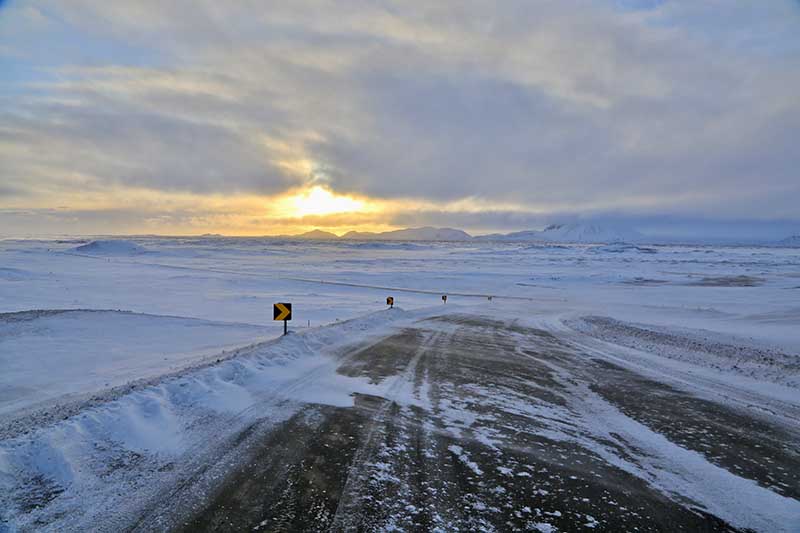
Essential Tips for Safe Winter Driving
Having the right winter car rental is the first step. The second is adapting your driving to the environment.
Quick Tips for Winter Driving
- Check Road & Weather Updates: Before every trip, review the latest conditions on vedur.is and road.is.
- Beware of Black Ice: Especially common near 0°C and in shaded areas, bridges, and overpasses.
- Drive Slowly: Posted limits are for ideal conditions—reduce speed on snow or ice.
- Keep Your Distance: Allow at least five seconds between vehicles.
- Use Headlights Always: Required at all times for safety and compliance.
- Avoid Sudden Moves: Steer, accelerate, and brake gently to retain control.
- Plan for Short Daylight: Prioritize travel during daylight hours and adjust your schedule for winter’s limited light.
- Keep a Full Tank: Fuel stations are spaced out, especially in rural areas.
- Carry Emergency Supplies: Extra clothes, snacks, water, and a phone charger are essential.
- Book 4x4 with Studded Tyres: For added traction, stability, and peace of mind.
- Slow Down: The posted speed limit (90 km/h on paved roads) is a maximum, not a target. Reduce your speed significantly on snowy or icy surfaces.
- Increase Following Distance: It takes much longer to stop on ice. Keep a safe distance of at least five seconds from the vehicle in front of you.
- Drive with Headlights On: Icelandic law requires headlights to be on 24/7, all year round. This is crucial for visibility during the short winter daylight hours.
- Be Gentle with Controls: Avoid sudden acceleration, braking, or steering movements, as these can cause you to lose traction.
- Beware of Black Ice: Black ice is a nearly invisible, thin layer of ice that forms when moisture freezes on the road—often when temperatures hover around 0°C. It is especially common after thawing and refreezing, and most dangerous on bridges, overpasses, and shaded areas where cold air circulates beneath the road surface. Because black ice looks just like wet pavement, it can catch even experienced drivers off guard, making it a leading cause of winter road accidents in Iceland.
- How to spot and avoid black ice: Be extra cautious if the road looks unusually glossy or shiny, especially in early mornings or late evenings. Always reduce speed when the temperature approaches freezing, avoid sudden braking or sharp steering, and increase your following distance. If your car feels unusually light or begins sliding, steer gently in the direction you want to go and do not overcorrect. Always check for black ice warnings on local road information sites before setting out.
- Handle Wind with Care: Strong wind gusts can affect your vehicle’s stability. Reduce your speed, keep both hands firmly on the wheel, and be prepared for sudden movements.
- Plan Around Daylight: In mid-winter (December-January), daylight is limited to about 4-5 hours. Plan your driving during these hours and allow for flexibility in your schedule.
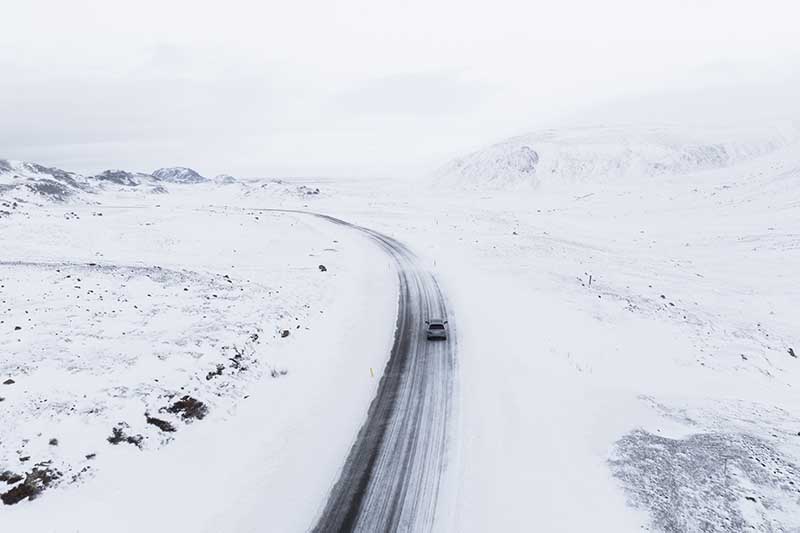
Your Winter Car Rental with Höldur - Europcar
Your winter adventure starts with us. As Iceland's largest car rental service and the official Europcar franchisee, Holdur-Europcar delivers global service standards backed by sixty years of local expertise. We're dedicated to making your journey safe and effortless.
Winter-Ready Fleet
Our entire fleet is equipped with studded tyres during the mandatory winter period at no extra cost. We offer a wide range of vehicles, including a large selection of modern 4x4 SUVs to suit your itinerary.
Comprehensive Protection
Iceland’s conditions can be tough on vehicles. We recommend our Premium Protection package, which includes coverage for common risks not always included in standard waivers, such as Gravel Protection (GP) and Sand and Ash Damage Waiver (SADW). This ensures peace of mind so you can focus on the journey. Our premium Damage Cover reduces your excess of the SCDW insurance to a Zero amount.
24/7 Support
Should you encounter any issues, our 24/7 roadside assistance is just a phone call away. Whether you have a question about your vehicle or need help in an emergency, our team is ready to support you.
Best rental cars for driving in Iceland in winter
Frequently Asked Questions (FAQs)
Do I need a 4x4 for driving in Iceland in winter?
While not legally required for all roads, a 4x4 is highly recommended for any travel outside of Reykjavík. It provides crucial safety advantages in terms of traction, clearance, and stability in snow, ice, and high winds.
Are all rental cars equipped with winter tyres?
Yes, at Höldur, all our vehicles are equipped with studded winter tyres from November 1st to April 15th, in compliance with Icelandic law and to ensure our customers' safety.
Can I drive the entire Ring Road in winter?
It is often possible, as the Ring Road is a priority for snow clearing. However, sections in the north and east can be temporarily closed due to heavy snow or storms. Always check Road.is before you travel and have a flexible itinerary.
What should I do if I get caught in a snowstorm?
If visibility becomes poor or driving feels unsafe, find a safe place to pull over (not on the road itself), turn on your hazard lights, and wait for conditions to improve. It’s better to be delayed than to risk an accident. Stay in your vehicle and call 112 for help if you are in an emergency.
How cold does Iceland get in winter?
The average Iceland winter temperature in the south is around 0°C (32°F). It is colder in the north and inland. However, strong winds can make it feel much colder, so dressing in warm, waterproof layers is essential.
Ready to Explore? Book Your Winter-Ready Rental Car
An Iceland winter road trip is the adventure of a lifetime. By choosing the right vehicle, respecting the weather, and driving cautiously, you can safely explore the breathtaking beauty of the land of fire and ice.
Return to the main Driving in Iceland page.

